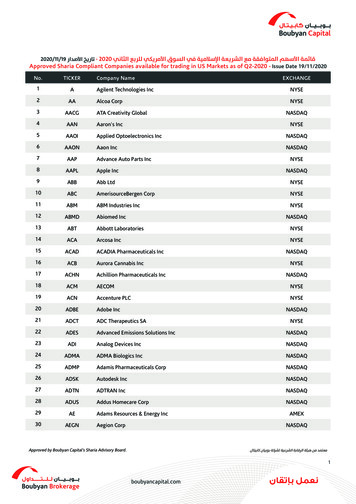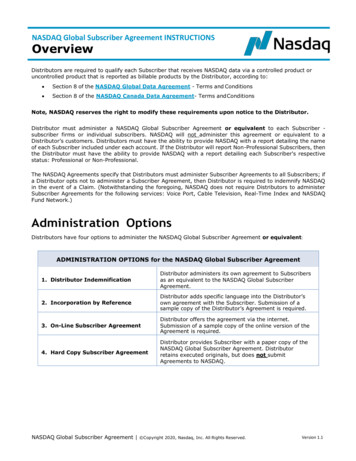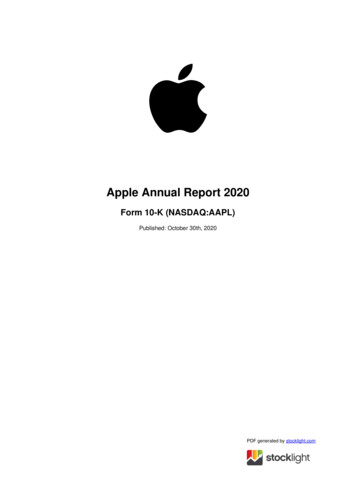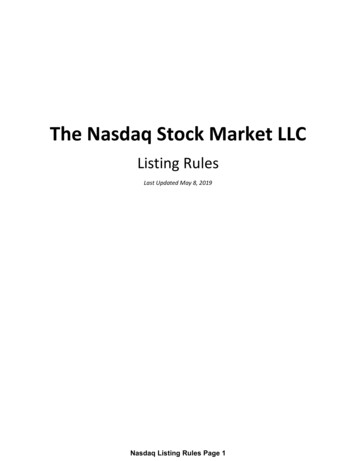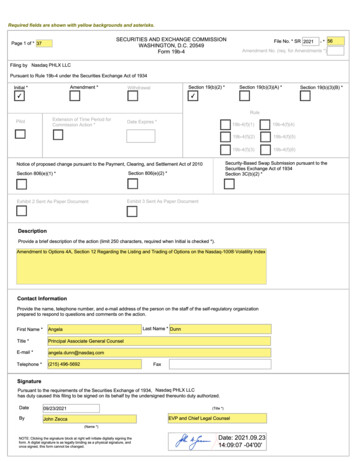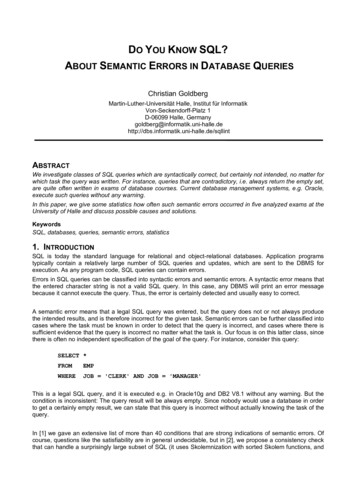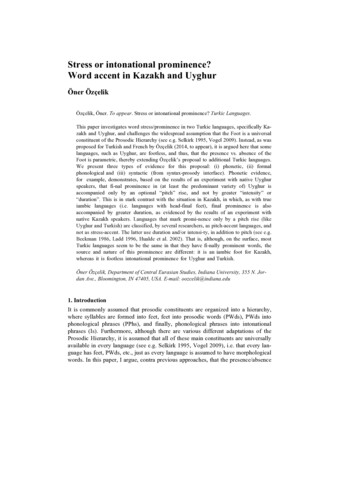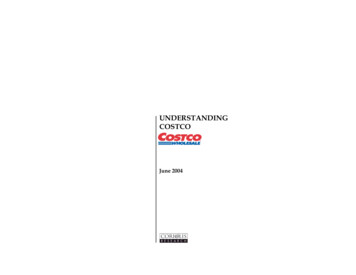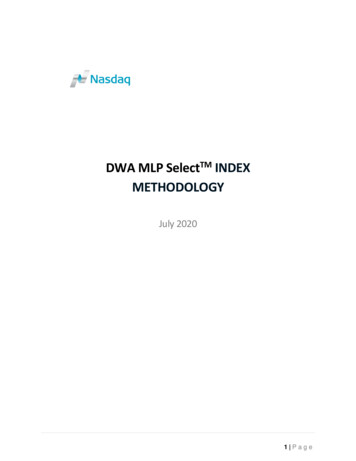
Transcription
DWA MLP SelectTM INDEXMETHODOLOGYJuly 20201 Page
TABLE OF CONTENTSTABLE OF CONTENTS . 21.Introduction . 42.Security Eligibility. 42.1Overview OF Selection CRITERIA for DWA MLP Select Index . 42.2Detailed Security Selection Criteria . 52.2.1 Security Types. 52.2.2 Market Capitalization. 52.2.3 Liquidity . 53.2.3INDEX EVALUATION. 52.4The Dorsey Wright Relative Strength Ranking Methodology . 5Index Calculations . 83.1Last Sale Price . 93.2Index Shares . 93.3Index Security Market Value and Index Market Value . 93.4Base Date . 93.5Base Value . 103.6PRICE RETURN DIVISOR . 103.7Price Return Index Value Calculation . 103.8Gross Total Return Index. 103.9Net Total Return Index . 114.Index Dissemination. 115.INDEX MAINTENANCE . 125.1Index Rebalancing . 125.2Index Security Changes. 125.2.1 Bankruptcy. 125.3Index Share Changes . 126. Corporate Actions . 136.1Stock Split and Stock Dividend . 136.2Reverse Stock Split . 136.3Special Cash Dividends . 136.4Cash and Stock Dividends . 136.5Stock Distribution of Another Security. 142 Page
6.6Spin-offs. 146.7Rights Offerings. 147.General Announcement Policy. 158.Discretionary Adjustments . 16About NASDAQ Global Indexes . 17About Nasdaq, Inc. . 17Disclaimer . 17Limits of Liability . 183 Page
1.INTRODUCTIONThe DWA MLP SelectTM Index includes 15 Master Limited Partnerships (MLPs) based on the proprietary DorseyWright Relative Strength Ranking Methodology. Relative strength measures how one security is performing inrelation to another in an effort to identify which security is outperforming the other. By comparing the pricerelationship between each MLP, the Index seeks to determine which MLPs are currently showingoutperformance relative to their peers within the Index universe. These comparisons are conducted via Point &Figure relative strength charting, which results in the identification of the MLP (as described below) that hasestablished a trend of relative outperformance (a Buy Signal, as described below), or underperformance (a SellSignal, as described below), within each comparison. The Buy Signals and Sell Signals of the Index methodologyare objective in nature, as price data is the only input within DWA’s relative strength calculation.On a monthly basis, the Index will select the top 15 MLPs exhibiting the largest positive relative strengthcharacteristics. Each MLP included in the index will be equal-weighted.“US market trading day” means any day on which any United States stock exchange (that has eligiblecomponents for the index as prescribed in section 2) are open for trading during their respective regular tradingsessions, notwithstanding either exchange closing prior to its scheduled weekday closing time.The Index provides a transparent, rules-based benchmark for investors and is calculated as Price Return, TotalReturn and Net Total Return. DWA MLP Select Index (DWAMLP) DWA MLP Select Total Return Index (DWAMLPT) DWA MLP Select NTR Index (DWAMLPN)2.SECURITY ELIGIBILITY2.1OVERVIEW OF SELECTION CRITERIA FOR DWA MLP SELECT INDEXTo be eligible for initial inclusion in the DWA MLP SelectTM Index (“The Index”), an Index Security1 must meet thefollowing criteria:1 must be listed on a United States stock exchange; have a minimum market capitalization of 250 million; have a minimum one month average daily dollar trading volume of 2 million per day on itsprimary exchange; the security may not be issued by an issuer currently in bankruptcy proceedings; and the issuer of the security may not have entered into a definitive agreement or other arrangementwhich would likely result in the security no longer being Index eligible.An Index Security is defined as a security meeting all eligibility requirements for the Index.4 Page
2.2DETAILED SECURITY SELECTION CRITERIA2.2.1SECURITY TYPESIndex eligibility is limited to publicly traded Master Limited Partnership (MLPs) structured as a limitedpartnership. MLPs classified as Financials according to the Industry Classification Benchmark (ICB) are noteligible for inclusion.2.2.2MARKET CAPITALIZATIONThere is a minimum market capitalization of 250 million. Market capitalization is determined by multiplying asecurity’s Last Sale Price2 by its total shares outstanding.2.2.3LIQUIDITYEach security must have a minimum one month average daily dollar trading volume of 2 million per day on itsprimary exchange.2.3INDEX EVALUATIONMLPs will be selected that have been determined to show positive relative strength characteristics per theproprietary Dorsey Wright Relative Strength Ranking Methodology. The eligibility criteria are applied usingmarket data five business days prior to the end of each calendar month. The top 15 MLPs meeting the criteriaare included in the Index. Security additions and deletions are made effective after the closing of trading on thelast business day of each calendar month.Additionally, if at any time during the year other than the Evaluation, an Index Security is determined to havebecome ineligible for continued inclusion in the Index due to bankruptcy, delisting, or a definitive agreementthat would likely result in the security no longer being Index eligible, the security is removed from the Index andis not replaced. Ordinarily, a security will be removed from the Index at its Last Sale Price. If, however, at thetime of its removal the Index Security is halted from trading on its primary listing market and an official closingprice cannot readily be determined, the Index Security may, in Nasdaq’s discretion, be removed at a zero price.The zero price will be applied to the Index Security after the close of the market but prior to the time the officialclosing value of the Index is disseminated, which is ordinarily 17:16:00 ET.2.4 THE DORSEY WRIGHT RELATIVE STRENGTH RANKINGMETHODOLOGYDorsey Wright & Associates (”DWA”) uses technical analysis to identify MLP’s that DWA believes are technicalleaders within an inventory of MLPs that meet specific guidelines. Technical analysis analyzes past price changesto determine buy or sell signals based on certain patterns. Price data is the only input within DWA’s relativestrength calculation. 2Point & Figure Charting: Point & Figure charting is a logical, organized way of recording supply anddemand imbalances within a security, focusing on the price movements of that security. Point & FigureSee Section 4.1 for description of Last Sale Price.5 Page
charts filter out insignificant price movements by ignoring small price fluctuations, trading volume andtime.Relative Strength: Relative Strength is another technical analysis tool that measures a security'sperformance relative to other securities in the same industry, competitive industry, benchmark orbroad market indices. Relative Strength is a way of recording historic performance patterns, and DWAuses Relative Strength signals as a trend indicator for current momentum and future performancetrends of one security versus another.DWA builds Relative Strength charts for each MLP as compared to each other MLP using the following process:(i)On a daily basis, DWA computes the ratio of the closing price of each MLP to the closing price ofeach other MLP.Example: using Access Midstream Partners (ACMP) and El Paso Pipeline (EPB) as of 11/05/2013 :Relative Strength (ACMP, EPB) (ACMP Closing Price / EPB Closing Price) 100 52.72/ 40.41 100 130.46(ii)As a result of on-going calculations, a Point & Figure Relative Strength chart is created for MLPversus each other MLP in the universe. A Point & Figure Relative Strength chart is a variation of aPoint & Figure chart but its input value is computed in the previous step, instead of individualsecurity prices.The vertical axis of the chart represents the Point & Figure Relative Strength values and isconstituted of a discrete number of intervals (“Boxes”).The Relative Strength values are reported day after day on each chart using a specific process:a. If the new Relative Strength value is within the same box of the preceding day, nothing isreported on the chart;b. If the new Relative Strength value is above the box of the preceding day, a new X is reported onthe chart. When reporting a new X, it is reported in the same column if the previous reportedindicator was already a X. Otherwise, it is reported in the next right column;c. If the new Relative Strength value is three boxes below the current X, a new column of O’s isreported on the chart. When reporting a new O, it is reported in the same column if the existingcolumn was already an O. Otherwise, it is reported in the next right column.Relative Strength Value thresholds of outperformance or underperformance by the one MLP ascompared to another MLP, are measured in increments of 3.25%The Point & Figure Relative Strength chart built upon the above process is a succession of “X”columns and “O” columns.ACMP vs EPB scale 3.25 as of 11/5/20136 Page
Months symbols: The numbers 1 to 9 (January to September) and the letters A, B, and C (Octoberto December) present Relative Strength charts are calendar month marks. Year starts are alsonoted as reference under the chart. Those calendar marks have no significance for themethodology except as reference points, and otherwise act as an “X” or “O” consistent with othercharacters in the same column.For each Relative Strength relationship between two MLPs, the most important information from that relationshipis conveyed with a two-letter symbol (“BX”, “BO”, “SX” or “SO”). This symbol relays a synthetic analysis of thecurrent Relative Strength relationship, illustrating which MLP maintains a trend of outperformance versus theother on a near term and longer term basis.When a column of X’s exceeds a previous column of X’s, the chart indicates a “Buy Signal” (also referred to aspositive relative strength). Conversely, “Sell Signals” are given when a column of O’s exceeds a previous columnof O’s (also referred to as negative relative strength).On a daily basis, DWA assigns one of the following two-letter symbols to all relative strength relationships that aremonitored within a relative strength matrix:“BX”, if Relative Strength chart is as of that day on a buy signal and in a column of X’s“BO”, if Relative Strength chart is as of that day on a buy signal and in a column of O’s“SX”, if Relative Strength chart is as of that day on a sell signal and in a column of X’s“SO”, if Relative Strength chart is as of that day on a sell signal and in a column of O’s7 Page
DWA created the Relative Strength Matrix to analyze large numbers of charts and to easily display an equally largedata set of signals. The Relative Strength Matrix is ranked such that the MLP with the highest number of BuySignals is ranked #1, and appears at the top of the Relative Strength Matrix. The MLP with the lowest number isranked last and appears on the bottom of the Relative Strength Matrix.3.INDEX CALCULATIONSThe DWA MLP SelectTM Index is an equal-weighted index. The value of the Index equals the aggregate value ofthe Index share weights, also known as the Index Shares, of each of the Index Securities multiplied by each suchsecurity’s Last Sale Price, and divided by the divisor of the Index. The divisor serves the purpose of scaling suchaggregate value to a lower order of magnitude which is more desirable for reporting purposes. If trading in anIndex Security is halted on its primary listing market, the most recent Last Sale Price for that security is used forall index computations until trading on such market resumes. Likewise, the most recent Last Sale Price is used iftrading in a security is halted on its primary listing market before the market is open. The Index began on May1, 2015, at a base value of 1000.00.8 Page
Three versions of the Index are calculated: The price return index in USD (Nasdaq: DWAMLP) is ordinarily calculated without regard to cashdividends on Index Securities. The total return index in USD (Nasdaq: DWAMLPT) reinvests cash dividends on the ex-date. The net total return index in USD (Nasdaq: DWAMLPN) reinvests cash dividends on the ex-date basedon the securities incorporation withholding rate.All index calculations reflect extraordinary cash distributions.The Indexes are calculated during the trading day based on the Last Sale Price and are disseminated once persecond from 09:30:01 to 17:16:00 ET. The closing value of the Indexes may change up until 17:15:00 ET due tocorrections to the Last Sale Price of the Index Securities.3.1LAST SALE PRICEThe Last Sale Price refers to the closing price reported on each Index Security’s Index Market. The Index Marketis the primary stock exchange on which an index security is listed for which the Index Security’s prices arereceived and used by Nasdaq in the Index calculation.If an Index Security does not trade on its Index Market on a given day or the Index Market has not opened fortrading, the most recent Last Sale Price from the Index Market (adjusted for corporate actions, if any) is used. Ifan Index Security is halted during the trading day the most recent Last Sale Price is used until trading resumes.If an Index Security is removed from an Index, it will ordinarily be removed at its Last Sale Price. If, however, atthe time of its removal the Index Security is halted from trading on its Index Market and a Last Sale Price cannotreadily be determined, the Index Security may, at Nasdaq’s discretion, be removed at a price of 0.00000001(“zero price”). This price will be applied to the Index Security after the close of all the trading markets in theIndex but prior to the time the official closing value of the Index is disseminated.3.2INDEX SHARESIndex Shares are based on the shares assigned to each Index Security in the equal weighted share calculationprocess. For further information, refer to section 5.1 (Index Rebalancing).3.3INDEX SECURITY MARKET VALUE AND INDEX MARKET VALUEThe Index Security Market Value is the Last Sale Price of the Index Security multiplied by its Index Shares. TheIndex Market Value is the aggregate of each of the Index Security’s Market Values.3.4BASE DATEThe Base Date is the date the Index began to be calculated. The Index began on May 1, 2015.9 Page
3.5BASE VALUEThe Base Value is the starting value for the Index. The Index began at a base value of 1000.00.3.6PRICE RETURN DIVISORThe Divisor serves the purpose of scaling an Index Market Value to a lower order of magnitude which isrecommended for reporting purposes. The Divisor is adjusted to ensure that changes in Index Securities eitherby corporate actions or index participation occurring outside of trading hours do not affect the value of theIndex. All Divisor changes occur after the close of Index Security markets contained in the Index.The Price Return Index Divisor for day t is calculated as the ratio of the Start of Day (SOD) market value and theprevious day index value as follows:𝐼𝑛𝑑𝑒𝑥 𝑆𝑂𝐷 𝑀𝑎𝑟𝑘𝑒𝑡 𝑉𝑎𝑙𝑢𝑒𝑡𝑃𝑟𝑖𝑐𝑒 𝑅𝑒𝑡𝑢𝑟𝑛 𝐼𝑛𝑑𝑒𝑥 𝐷𝑖𝑣𝑖𝑠𝑜𝑟𝑡 𝑃𝑟𝑖𝑐𝑒 𝑅𝑒𝑡𝑢𝑟𝑛 𝐸𝑂𝐷 𝐼𝑛𝑑𝑒𝑥𝑡 13.7PRICE RETURN INDEX VALUE CALCULATIONThe Price Return Index value reflects changes in market value of Index Securities during the trading day and iscalculated without regard to ordinary cash dividends, but includes special dividends and the formula is asfollows:𝑃𝑟𝑖𝑐𝑒 𝑅𝑒𝑡𝑢𝑟𝑛 𝐸𝑂𝐷 𝐼𝑛𝑑𝑒𝑥𝑡 3.8𝐼𝑛𝑑𝑒𝑥 𝐸𝑂𝐷 𝑀𝑎𝑟𝑘𝑒𝑡 𝑉𝑎𝑙𝑢𝑒𝑡𝑃𝑟𝑖𝑐𝑒 𝑅𝑒𝑡𝑢𝑟𝑛 𝐼𝑛𝑑𝑒𝑥 𝐷𝑖𝑣𝑖𝑠𝑜𝑟𝑡GROSS TOTAL RETURN INDEXThe Gross Total Return Index value reflects ordinary cash and special dividends and the formula is as follows:𝐺𝑟𝑜𝑠𝑠 𝑇𝑜𝑡𝑎𝑙 𝑅𝑒𝑡𝑢𝑟𝑛 𝐼𝑛𝑑𝑒𝑥𝑡 𝐺𝑟𝑜𝑠𝑠 𝑇𝑜𝑡𝑎𝑙 𝑅𝑒𝑡𝑢𝑟𝑛 𝐼𝑛𝑑𝑒𝑥𝑡 1 𝑥𝑃𝑟𝑖𝑐𝑒 𝑅𝑒𝑡𝑢𝑟𝑛 𝐼𝑛𝑑𝑒𝑥𝑡 𝐼𝐷𝑃𝑃𝑟𝑖𝑐𝑒 𝑅𝑒𝑡𝑢𝑟𝑛 𝐼𝑛𝑑𝑒𝑥𝑡 1𝐺𝑟𝑜𝑠𝑠 𝑇𝑜𝑡𝑎𝑙 𝑅𝑒𝑡𝑢𝑟𝑛 𝐼𝑛𝑑𝑒𝑥𝑡 𝑡ℎ𝑒 𝑣𝑎𝑙𝑢𝑒 𝑜𝑓 𝑡ℎ𝑒 𝐺𝑟𝑜𝑠𝑠 𝑇𝑜𝑡𝑎𝑙 𝑅𝑒𝑡𝑢𝑟𝑛 𝐼𝑛𝑑𝑒𝑥 𝑜𝑛 𝑐𝑢𝑟𝑟𝑒𝑛𝑡 𝑑𝑎𝑦𝐺𝑟𝑜𝑠𝑠 𝑇𝑜𝑡𝑎𝑙 𝑅𝑒𝑡𝑢𝑟𝑛 𝐼𝑛𝑑𝑒𝑥𝑡 1 the previous day' s closing Gross Total Return Index value𝑃𝑟𝑖𝑐𝑒 𝑅𝑒𝑡𝑢𝑟𝑛 𝐼𝑛𝑑𝑒𝑥𝑡 𝑡ℎ𝑒 𝑣𝑎𝑙𝑢𝑒 𝑜𝑓 𝑡ℎ𝑒 𝑃𝑟𝑖𝑐𝑒 𝑅𝑒𝑡𝑢𝑟𝑛 𝐼𝑛𝑑𝑒𝑥 𝑜𝑛 𝑐𝑢𝑟𝑟𝑒𝑛𝑡 𝑑𝑎𝑦𝑃𝑟𝑖𝑐𝑒 𝑅𝑒𝑡𝑢𝑟𝑛 𝐼𝑛𝑑𝑒𝑥𝑡 1 the previous day' s closing Price Return Index value𝐼𝑛𝑑𝑒𝑥 𝐷𝑖𝑣𝑖𝑑𝑒𝑛𝑑 𝑀𝑎𝑟𝑘𝑒𝑡 ���𝑥 𝐷𝑖𝑣𝑖𝑑𝑒𝑛𝑑 𝑃𝑜𝑖𝑛𝑡𝑠) 𝑃𝑟𝑖𝑐𝑒 𝑅𝑒𝑡𝑢𝑟𝑛 𝐼𝑛𝑑𝑒𝑥 �� 𝐷𝑖𝑣𝑖𝑑𝑒𝑛𝑑 𝑀𝑎𝑟𝑘𝑒𝑡 𝑉𝑎𝑙𝑢𝑒𝑡 sum of the Index Security Dividend Market Values (SOD or EOD) for all Index Securitieson current day𝐼𝑛𝑑𝑒𝑥 𝑆𝑒𝑐𝑢𝑟𝑖𝑡𝑦 𝐷𝑖𝑣𝑖𝑑𝑒𝑛𝑑 𝑀𝑎𝑟𝑘𝑒𝑡 𝑉𝑎𝑙𝑢𝑒𝑡 dividend per share, for Index Security with ex-dividenddate on the current day multiplied by the Index Shares of that Index Security10 P a g e
3.9NET TOTAL RETURN INDEXThe Net Total Return Index value reflects ordinary cash and special dividends adjusted for withholding taxrates (WTR as defined for each country is found in Appendix D of the Nasdaq Global Index Family IFamilyMethodology.pdf] and the formula is as follows):𝑁𝑒𝑡 𝑇𝑜𝑡𝑎𝑙 𝑅𝑒𝑡𝑢𝑟𝑛 𝐼𝑛𝑑𝑒𝑥𝑡 𝑁𝑒𝑡 𝑇𝑜𝑡𝑎𝑙 𝑅𝑒𝑡𝑢𝑟𝑛 𝐼𝑛𝑑𝑒𝑥𝑡 1 𝑥𝑁𝑒𝑡 𝑃𝑟𝑖𝑐𝑒 𝑅𝑒𝑡𝑢𝑟𝑛 𝐼𝑛𝑑𝑒𝑥𝑡 𝑁𝑒𝑡𝐼𝐷𝑃𝑡𝑁𝑒𝑡 𝑃𝑟𝑖𝑐𝑒 𝑅𝑒𝑡𝑢𝑟𝑛 𝐼𝑛𝑑𝑒𝑥𝑡 1𝑁𝑒𝑡 𝑇𝑜𝑡𝑎𝑙 𝑅𝑒𝑡𝑢𝑟𝑛 𝐼𝑛𝑑𝑒𝑥𝑡 𝑡ℎ𝑒 𝑣𝑎𝑙𝑢𝑒 𝑜𝑓 𝑡ℎ𝑒 𝑁𝑒𝑡 𝑇𝑜𝑡𝑎𝑙 𝑅𝑒𝑡𝑢𝑟𝑛 𝐼𝑛𝑑𝑒𝑥 𝑜𝑛 𝑐𝑢𝑟𝑟𝑒𝑛𝑡 𝑑𝑎𝑦𝑁𝑒𝑡 𝑇𝑜𝑡𝑎𝑙 𝑅𝑒𝑡𝑢𝑟𝑛 𝐼𝑛𝑑𝑒𝑥𝑡 1 the previous day' s closing Net Total Return Index value𝑁𝑒𝑡 𝑃𝑟𝑖𝑐𝑒 𝑅𝑒𝑡𝑢𝑟𝑛 𝐼𝑛𝑑𝑒𝑥𝑡 𝑡ℎ𝑒 𝑣𝑎𝑙𝑢𝑒 𝑜𝑓 𝑡ℎ𝑒 𝑁𝑒𝑡 𝑃𝑟𝑖𝑐𝑒 𝑅𝑒𝑡𝑢𝑟𝑛 𝐼𝑛𝑑𝑒𝑥 𝑜𝑛 𝑐𝑢𝑟𝑟𝑒𝑛𝑡 𝑑𝑎𝑦𝑁𝑒𝑡 𝑃𝑟𝑖𝑐𝑒 𝑅𝑒𝑡𝑢𝑟𝑛 𝐼𝑛𝑑𝑒𝑥𝑡 1 the previous day' s closing Net Price Return Index value𝑁𝑒𝑡 𝑃𝑟𝑖𝑐𝑒 𝑅𝑒𝑡𝑢𝑟𝑛 𝐼𝑛𝑑𝑒𝑥𝑡 𝑁𝑒𝑡 𝑃𝑟𝑖𝑐𝑒 𝑅𝑒𝑡𝑢𝑟𝑛 𝐼𝑛𝑑𝑒𝑥 𝑀𝑎𝑟𝑘𝑒𝑡 𝑉𝑎𝑙𝑢𝑒𝑡𝑁𝑒𝑡 𝑃𝑟𝑖𝑐𝑒 𝑅𝑒𝑡𝑢𝑟𝑛 𝐼𝑛𝑑𝑒𝑥 𝐷𝑖𝑣𝑖𝑠𝑜𝑟𝑡Net Price Return Index value is not publically distributed. It is calculated only as the basis for the Net Total Return Index.𝑁𝑒𝑡 𝐼𝐷𝑃(𝑁𝑒𝑡 𝐼𝑛𝑑𝑒𝑥 𝐷𝑖𝑣𝑖𝑑𝑒𝑛𝑑 𝑃𝑜𝑖𝑛𝑡𝑠) 𝐼𝑛𝑑𝑒𝑥 𝑁𝑒𝑡 𝐷𝑖𝑣𝑖𝑑𝑒𝑛𝑑 𝑀𝑎𝑟𝑘𝑒𝑡 𝑉𝑎𝑙𝑢𝑒𝑡𝑁𝑒𝑡 𝑃𝑟𝑖𝑐𝑒 𝑅𝑒𝑡𝑢𝑟𝑛 𝐼𝑛𝑑𝑒𝑥 𝐷𝑖𝑣𝑖𝑠𝑜𝑟𝑡𝑁𝑒𝑡 𝐼𝑛𝑑𝑒𝑥 𝐷𝑖𝑣𝑖𝑑𝑒𝑛𝑑 𝑀𝑎𝑟𝑘𝑒𝑡 𝑉𝑎𝑙𝑢𝑒𝑡 sum of the Security Dividend Market Values (SOD or EOD)adjusted for withholding tax rate for all Index Securities on current day𝑁𝑒𝑡 𝐼𝑛𝑑𝑒𝑥 𝑆𝑒𝑐𝑢𝑟𝑖𝑡𝑦 𝐷𝑖𝑣𝑖𝑑𝑒𝑛𝑑 𝑀𝑎𝑟𝑘𝑒𝑡 𝑉𝑎𝑙𝑢𝑒𝑡 dividend per share adjusted for withholding tax rate (WTR) for IndexSecurity with ex-dividend date on the current day multiplied by the Index Shares of that Index Security4.INDEX DISSEMINATIONThe Index Values are calculated during the U.S. market trading day and are disseminated once per second.11 P a g e
5.INDEX MAINTENANCE5.1INDEX REBALANCINGThe Index employs an equal-dollar weighting methodology such that each security’s Index market is set to anequal dollar value corresponding to an equal percent weight of the Index’s aggregate market value. The equaldollar weighting occurs monthly, even when there are no changes made to the holdings of the Index. IndexShares are calculated by dividing this equal-dollar value for each Index Security by the corresponding last saleprice of the security at the close of trading on the last business day of each calendar month. The Index Sharechanges are effective after the closing of trading on the last business day of each calendar month.5.2INDEX SECURITY CHANGESIf, at any time during the year other than the Evaluation, an Index Security is determined to have becomeineligible for continued inclusion in the Index due to bankruptcy, delisting, or a definitive agreement that wouldlikely result in the security no longer being Index eligible, the security is removed from the Index and is notreplaced.5.2.1BANKRUPTCYIf a company files for bankruptcy, the Index Security will be removed from the Index as soon as practicablethereafter. The value of the Index Security will be considered 0.00000001 (“zero price”), if no other applicableprice can be observed on the primary exchange.5.3INDEX SHARE CHANGESIndex Share changes are not made during the month however changes arising from stock dividends and stocksplits are made to the Index on the evening prior to the effective date of such corporate action. In the case ofcertain spin-offs or rights issuances, the price of the Index Security is adjusted and a corresponding adjustmentis made to the Index Shares such that the weight of the Index Security does not change as a result of the action.A special cash dividend announced by the listing exchange, will result in an adjustment to the Last Sale Price ofan Index Security prior to market open on the ex-date for the special amount distributed. A correspondingadjustment will be made to the Index Shares of the security such that the weight of the Index Security will notchange as a result of the action. A special dividend may also be referred to as extra, extraordinary, nonrecurring, one-time, unusual, etc.In the case of a special cash dividend, a determination is made on an individual basis as to whether to make achange to the price of an Index Security in accordance with its Index dividend policy. If it is determined that achange will be made, a corresponding adjustment will be made to the Index Shares of the security such that theweight of the Index Security will not change as a result of the action. Any such change will become effective onthe ex-date.12 P a g e
6. CORPORATE ACTIONSThe following corporate actions will be made effective in the Index on the ex-date. If there is no ex-dateannounced by the primary stock exchange on which an index security is listed, there will be no adjustment tothe Index as a result of a Corporate Action.6.1STOCK SPLIT AND STOCK DIVIDENDA stock split and stock dividend is the action of an Index Security in increasing its Index Shares and decreasingthe par value in proportion. There is no flow of capital into or out of the company. The number of Index Sharesincreases but the market capitalization of the company remains unchanged.The price of the Index Security is adjusted to reflect the ratio of a stock split and stock dividend and acorresponding inverse adjustment to the Index Shares is made.6.2REVERSE STOCK SPLITA reverse stock split is the action of an Index Security in decreasing its Index Shares and decreasing the par valuein proportion. There is no flow of capital into or out of the company. The number of Index Shares decreases butthe market capitalization of the company remains unchanged.The price of the Index Security is adjusted to reflect the ratio of the reverse stock split and a correspondinginverse adjustment to the Index Shares is made.6.3SPECIAL CASH DIVIDENDSA dividend is considered special if the information provided by the primary stock exchange on which an indexsecurity is listed in their announcement of the ex-date indicates that the dividend is special. Othernomenclature for a special dividend may be (but not limited to) extra, extraordinary, non-recurring, one-time,unusual, etc. The price of the Index Security is adjusted for the amount of the special cash dividend.6.4CASH AND STOCK DIVIDENDSIf an Index Security is paying a cash and stock dividend on the same date, the cash dividend is applied before thestock dividend unless otherwise indicated in the information provided by the primary stock exchange on whichan index security is listed. Additionally, in the case of an optional dividend which allows the holder to choosebetween receiving cash or stock, the adjustment will be made in the manner the dividend has been announcedby the primary stock exchange on which an index security is listed.13 P a g e
6.5STOCK DISTRIBUTION OF ANOTHER SECURITYIf an Index Security is distributing shares of a different security, the value of the Index Security will be adjusteddownward to reflect the ratio of the distribution. There is no adjustment to Index Shares.6.6SPIN-OFFSIf an Index Security is spinning off a security, the value of the Index Security will be adjusted downward toreflect the ratio of the distribution. There is no adjustment to Index Shares. If a when-issued market isestablished for the spun-off security, the price of the Index Security is adjusted downward by the value of thespinoff. The value of the spin-off is determined by multiplying the spin-off ratio by the when-issued price. In theevent the value of the spinoff has not been established as indicated above then no price adjustment is made tothe Index Security. The new security resulting from the spin-off transaction is not added to the Index.6.7RIGHTS OFFERINGSThe price of an Index Security is adjusted on the ex-date for rights offerings if the rights are transferable andhave a subscription price on an equivalent per share basis that is less than the closing price of the Index Securitythe right entitles a holder to purchase (the “Underlying Security”) on the day prior to the ex-date (in-themoney). The price of the Index Security is adjusted downward for the value of the right. The value of the right isdetermined by the previous Last Sale Price (LSP) of the Underlying Security minus the sum of the SubscriptionPrice of the right plus the cash dividend of the Underlying Security, if any, divided by the number of rightsrequired to purchase one share, plus one.14 P a g e
7.GENERAL ANNOUNCEMENT POLICYNasdaq announces Index-related information via our premier service Global Index Watch athttp://indexes.nasdaqomx.com.Corporate actions are implemented in the Indexes in accordance with the Index maintenance rules.Announcement is made prior to the effective date of the corporate actions.In the event that a change has been made to an Index intraday, an announcement will be made to informclients of the change.In the event that an Index calculation has been corrected historically an announcement will be provided andclients are asked to update their databases accordingly.15 P a g e
8.DISCRETIONARY ADJUSTMENTSNasdaq may, from time to time, exercise reasonable discretion as it deems appropriate in order to ensure Indexintegrity.16 P a g e
ABOUT NASDAQ GLOBAL INDEXESNasdaq Global Indexes has been creating innovative, market-leading, transparent indexes since 1971. Today ourindex offering spans geographies and asset classes and includes diverse families
Point & Figure chart but its input value is computed in the previous step, instead of individual security prices. The vertical axis of the chart represents the Point & Figure Relative Strength values and is constituted of a discrete number of intervals (" oxes"). The Relative Strength values are reported day after day on each chart using a .
